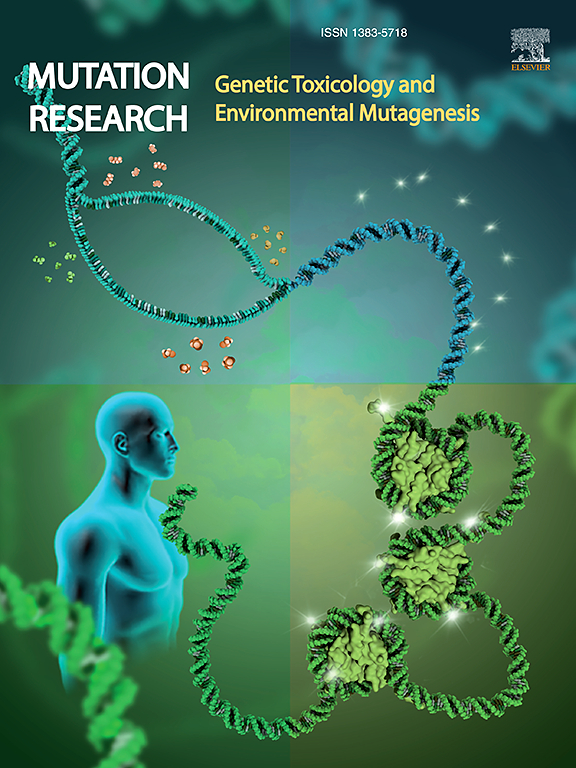木犀草素在丙烯酰胺诱导的胚胎成纤维细胞遗传毒性和凋亡调控中的作用
IF 2.5
4区 医学
Q3 BIOTECHNOLOGY & APPLIED MICROBIOLOGY
Mutation research. Genetic toxicology and environmental mutagenesis
Pub Date : 2025-02-01
DOI:10.1016/j.mrgentox.2025.503853
引用次数: 0
摘要
丙烯酰胺(Acr)是通过烹饪技术产生的,如油炸和烘烤,通常用于食品制备。由于Acr在经常消费的食品中普遍存在,因此其消费是不可避免的。对Acr有害后果的认识促使研究人员开展旨在减轻这些影响的实验。黄酮类化合物是植物的次生代谢产物,其抗氧化性能得到了广泛的研究。与其他类黄酮相比,木犀草素具有更高的抗氧化能力,并且在先前的研究中也显示出很强的dna保护作用。该研究涉及给Balb/c 3T3胚胎成纤维细胞注射Acr(0.5、1和2 mM)和Lut(10µM) 24 h。采用细胞活力和乳酸脱氢酶测定法评价Acr和Lut对3T3胚胎成纤维细胞的细胞毒作用。此外,采用碘化丙啶/Hoechst双荧光染色技术说明凋亡的后果。采用细胞分裂阻断微核分析和彗星试验对Acr的遗传毒性和Lut的细胞保护作用进行了评价。分析结果显示,胚胎成纤维细胞暴露于Acr浓度下,导致细胞活力显著降低,乳酸脱氢酶水平升高,微核频率增加,形成彗星。此外,当与Acr联合使用时,Lut已显示出抑制细胞毒性和遗传毒性。结果表明,Lut对Acr的遗传毒性具有改善作用。本文章由计算机程序翻译,如有差异,请以英文原文为准。
The role of luteolin in modulation of acrylamide-induced genotoxicity and apoptosis in embryonic fibroblast cells
Acrylamide (Acr) is generated through cooking techniques such as frying and roasting, commonly employed in food preparation. The consumption of Acr is unavoidable due to its prevalence in frequently consumed food products. Awareness of the detrimental consequences of Acr has prompted researchers to undertake experiments aimed at mitigating these effects. Flavonoids, the secondary metabolites of plants, have been researched for their antioxidant properties. Luteolin (Lut) exhibits higher antioxidant potency compared to many other flavonoids and has also shown strong DNA-protective properties in the previous research. The study involved the administration of Acr (0.5, 1, and 2 mM) and Lut (10 µM) to Balb/c 3T3 embryonic fibroblast cells for 24 h. The cytotoxic effect of Acr and Lut on 3T3 embryonic fibroblast cells was assessed using cell viability and lactate dehydrogenase assays. Furthermore, the propidium iodide/Hoechst double fluorescence staining technique was employed to illustrate the apoptotic consequences. The genotoxicity of Acr and the cytoprotective properties of Lut against this genotoxicity were evaluated using cytokinesis-blocking micronucleus analysis and the comet test. The analysis of the results revealed that exposure of embryonic fibroblast cells to Acr concentrations led to a significant reduction in cell viability, along with an elevation in lactate dehydrogenase enzyme levels, an increase in the frequency of micronuclei, and the formation of comets. Additionally, Lut has been shown to suppress both cytotoxicity and genotoxicity when used in combination with Acr. Consequently, it has been revealed that Lut has ameliorative effects on genotoxicity caused by Acr.
求助全文
通过发布文献求助,成功后即可免费获取论文全文。
去求助
来源期刊
CiteScore
3.80
自引率
5.30%
发文量
84
审稿时长
105 days
期刊介绍:
Mutation Research - Genetic Toxicology and Environmental Mutagenesis (MRGTEM) publishes papers advancing knowledge in the field of genetic toxicology. Papers are welcomed in the following areas:
New developments in genotoxicity testing of chemical agents (e.g. improvements in methodology of assay systems and interpretation of results).
Alternatives to and refinement of the use of animals in genotoxicity testing.
Nano-genotoxicology, the study of genotoxicity hazards and risks related to novel man-made nanomaterials.
Studies of epigenetic changes in relation to genotoxic effects.
The use of structure-activity relationships in predicting genotoxic effects.
The isolation and chemical characterization of novel environmental mutagens.
The measurement of genotoxic effects in human populations, when accompanied by quantitative measurements of environmental or occupational exposures.
The application of novel technologies for assessing the hazard and risks associated with genotoxic substances (e.g. OMICS or other high-throughput approaches to genotoxicity testing).
MRGTEM is now accepting submissions for a new section of the journal: Current Topics in Genotoxicity Testing, that will be dedicated to the discussion of current issues relating to design, interpretation and strategic use of genotoxicity tests. This section is envisaged to include discussions relating to the development of new international testing guidelines, but also to wider topics in the field. The evaluation of contrasting or opposing viewpoints is welcomed as long as the presentation is in accordance with the journal''s aims, scope, and policies.

 求助内容:
求助内容: 应助结果提醒方式:
应助结果提醒方式:


